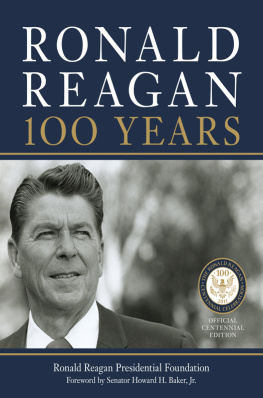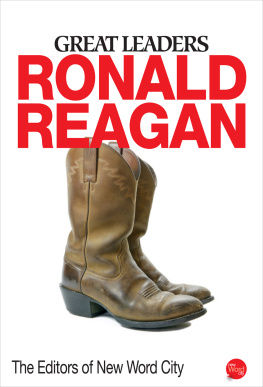


Simon & Schuster
1230 Avenue of the Americas
New York, NY 10020
www.SimonandSchuster.com
Copyright 1990 by Ronald W. Reagan
All rights reserved, including the right to reproduce this book or portions thereof in any form whatsoever. For information, address Simon & Schuster Subsidiary Rights Department, 1230 Avenue of the Americas, New York, NY 10020.
This Simon & Schuster hardcover edition January 2011
Simon & Schuster and colophon are registered trademarks of Simon & Schuster, Inc.
Designed by Eve Metz / Eric Ziman
Manufactured in the United States of America
10 9 8 7 6 5 4 3 2 1
Library of Congress Cataloging-in-Publication data
Reagan, Ronald.
An american life: the autobiography/Ronald Reagan.
p. cm.
Includes index.
1. Reagan, Ronald. 2. PresidentsUnited StatesBiography.
I. Title.
E877.R33 1990
973.927'092dc20
[B] 90-10093
CIP
ISBN: 978-1-4516-2073-3
ISBN: 978-1-4391-4148-9 (ebook)
Unless otherwise credited, all photos were taken by White House photographers and appear in the book courtesy of the Ronald Reagan Presidential Library.
Photo 1: AP/Wide World Photos; Photo 2: Ronald Reagan Home Preservation Foundation; Photo 3: 1926 Dixonian; Photos 5, 7, and 8: Reagan Family Collection; Photo 6: Photo courtesy of The Dixon Telegraph; Photos 9 and 10: Gene Trindl/Shooting Star; Photo 11: Michael Evans photo.
To Nancy. She will always be my first Lady. I cannot imagine life without her.
Acknowledgments
Presidential memoirs have become somewhat of a tradition recentlya way for a president to tell his story in his own words. And while that is what An American Life does, I had a great deal of help, for which I am most appreciative.
First of all, I thank my beloved wife, Nancy. There are really no words to describe what she means to me. Life with her is everything I always hoped it would be.
Robert Lindsey, a talented writer, was with me every step of the way. Bob has a way with words that has rightly earned him a reputation as one of our countrys most gifted authors. Even though I am glad to have this book finished, I will miss my conversations with Bob. Im also grateful to Bobs wife, Sandra, for her tireless work in typing Bobs notes.
The wonderful and thoroughly professional team at Simon and Schuster, under the able leadership of CEO Dick Snyder, were there day and night, always cheerful and always helpful. Editor in chief Michael Korda patiently read every single word time and time again, dotted every i and crossed every tno one could ask for a better editor. Charlie Hayward, Alice Mayhew, and Jack McKeown were also of invaluable assistance. And Mort Janklow, my literary agent, who assembled the whole group, played a key role in bringing this book to completion.
The staff in my Los Angeles office worked with me from the very firstresearching files, finding photographs, checking facts, jogging memories. Jeanine Chase, Dottie Dellinger, Kerry Geoghan, Cathy Goldberg, Peggy Grande, Jon Hall, Joanne Hildebrand, Selina Jackson, Bernadette Schurz, and Sheri Semonloyal and competent, they are the best team anyone could field.
Three persons in particular spent considerable time working with me on this book and deserve a special mention: Fred Ryan, my chief of staff, who came with me from the White House, where he skillfully managed my schedule and where he was the architect of one of my proudest achievementsthe Office of Private Sector Initiatives; Kathy Osborne, who has been my personal secretary since Sacramento and always knows just what I need (sometimes even before I do!); and Mark Weinberg, my director of public affairs, who for over ten years has articulately and effectively served as my ambassador to the press.
The dedicated team at the Ronald Reagan Presidential FoundationDoris Heller, Robert Higdon, Chuck Jelloian, John Lee, Suzanne Marx, Stefanie Salata, Marilyn Siegel, Pam Trowbridge, and Sandy Warfieldwill always have my gratitude for the work they are doing on the presidential library being built in the Simi-Thou-sand Oaks area of Ventura County.
And finally, I thank the men and women Nancy and I left behind. The question I am most often asked these days is whether I miss Washington. Although I enjoyed the presidency, I dont miss the job. What I do miss is the peoplethe good and decent people from every state in the union, from all walks of life, black and white, Christian and Jew, rich and poor, military and civilian, political and civil service, who comprise the executive office of the president of the United States, joined only by the desire to serve their country. They do so with the greatest dedication and distinction. We miss them, we keep them in our hearts, and we will always be grateful to them.
Ronald Reagan
Contents
Part I
From Dixon to Washington
Part II
The First Year
A New Beginning
Part III
Staying the Course
Part IV
The Middle East, Lebanon, Grenada
Part V
Iran-Contra
Part VI
Arms Control:
From Geneva to Reykjavik, Washington to Moscow
Prologue
N ANCY AND I AWOKE EARLY on the morning of November 19, 1985, and, at the first glimmer of daylight, we looked out from our bedroom at the long gray expanse of Lake Geneva. There were patches of snow along the edge of the lake and in the gardens of the magnificent lakeside eighteenth-century residence that had been loaned to us for a few days. In the distance we could see the majestic high peaks of the Alps.
The lake was shrouded in mist that gave its rippled surface the look of burnished pewter. Above, the sky was a dull curtain of dark clouds.
It was a dreary, yet strikingly beautiful panorama.
I had looked forward to this day for more than five years. For weeks, Id been given detailed information about political currents in the Soviet Union, the complexities of nuclear arms control, and the new man in the Kremlin. In my diary the night before, I wrote: Lord, I hope Im ready.
Neither Nancy nor I had slept very well since arriving in Geneva three days earlier. During the eight-hour flight from Washington, we tried to adjust to Swiss time by eating meals aboard Air Force One at the same hour Genevans were sitting down to theirs. Doctors said this would help reduce the effects of jet lag. Yet, as each night passed, I slept fitfully.
Perhaps it was jet lag, but I found it difficult not to think about what was ahead of me.
George Shultz told me that if the only thing that came out of this first meeting with Mikhail Gorbachev was an agreement to hold another summit, it would be a success. But I wanted to accomplish more than that.
I believed that if we were ever going to break down the barriers of mistrust that divided our countries, we had to begin by establishing a personal relationship between the leaders of the two most powerful nations on earth.
During the previous five years, I had come to realize there were people in the Kremlin who had a genuine fear of the United States. I wanted to convince Gorbachev that we wanted peace and they had nothing to fear from us. So I had gone to Geneva with a plan.
The Russians were bringing their team of diplomats and arms control experts and we were bringing ours. But I wanted a chance to see Gorbachev alone.
Since Gorbachev had taken office eight months earlier, he and I had quietly exchanged a series of letters that had suggested to me he might be a different sort of Russian than the Soviet leaders we had known before.
Next page












